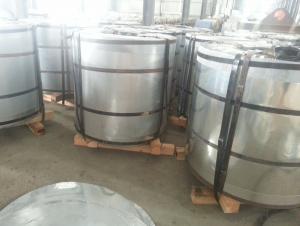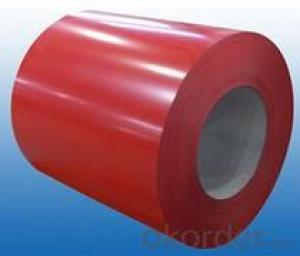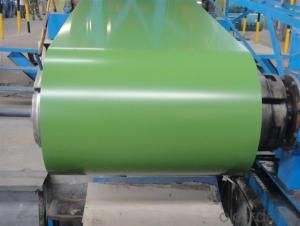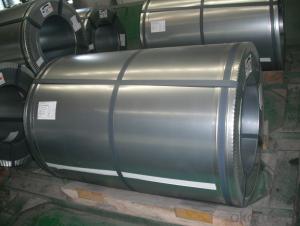Prepainted Galvanized Steel Sheet in Coils
- Loading Port:
- Shanghai
- Payment Terms:
- TT OR LC
- Min Order Qty:
- 25 m.t.
- Supply Capability:
- 10000 m.t./month
OKorder Service Pledge
OKorder Financial Service
You Might Also Like
Prepainted Galvanized Steel Sheet in Coils
1.Structure of Prepainted Galvanized Steel Sheet in Coils
1.Prepainted Galvanized Steel Sheet in Coils is coated with organic layer, which provides higher anti-corrosion property and a longer lifespan than that of galvanized steel sheets.
2. The base metals for Color Coated Steel Coil consist of cold rolled, HDG electro-galvanized and hot-dip alu-zinc coated steel. The finish coats of Color Coated Steel Coil can be classified into groups as follows: polyester, silicon modified polyesters, polyvinylidene fluoride, high-durability polyester, etc.
3. The production process has evolved from one-coating-and-one-baking to double-coating-and-double-baking, and even three-coating-and-three-baking.
4. The color of the Color Coated Steel Coil has a very wide selection, like orange, cream-colored, dark sky blue, sea blue, bright red, brick red, ivory white, porcelain blue, etc.
5. The Color Coated Steel Coil can also be classified into groups by their surface textures, namely regular prepainted sheets, embossed sheets and printed sheets,which is made by the processes of chemical preconditioning, first coating, precision coating and so on through a continuous rapid unit internationally in recent three decades. Its quality is more uniform and stable than the one whose surface of the formed metal is coated single or brushed one.
2.Main Features of Prepainted Galvanized Steel Sheet in Coils.
1) Rust-proof
2) Water-proof
3)Durable using
3. Prepainted Galvanized Steel Sheet in Coils Images
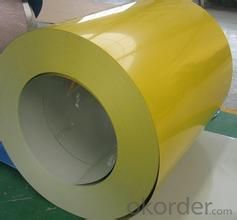

4. Prepainted Galvanized Steel Sheet in Coils Specification
1: Size: 0.15-1.2mm*600-1250mm
2: Paint: Top side: 15-25um, Back side: 5-9um, or according to customer’s order.
3: Base material: Hot dipped galvanized steel coil, GL
4: Zinc coating: 60g-275g.
5: Coil weight: 3-6tons
6: Coil ID: 508mm
7: Color: Any color.
8: Standard: ASTM, GB, JIS
9:Grade: CGCC,CGCH,SGCC, DX51D and ASTM
10:Surface Treatments: skin passed, chromated, oiled and antifinger
11: Approved Certificate: SGS / ISO9001 / BV
12: Package Method: Vertical/Horizontal, full wrapped with anti-moist paper inside, iron sheet (sea worthy)
13: Payments terms: T/T ,L/C,etc.
5.FAQ of Prepainted Galvanized Steel Sheet in Coils
We have organized several common questions for our clients,may help you sincerely:
①How about your company?
A world class manufacturer & supplier of castings forging in carbon steel and alloy steel,is one of the large-scale professional investment casting production bases in China,consisting of both casting foundry forging and machining factory. Annually more than 8000 tons Precision casting and forging parts are exported to markets in Europe,America and Japan. OEM casting and forging service available according to customer’s requirements.
②How to guarantee the quality of the products?
We have established the international advanced quality management system,every link from raw material to final product we have strict quality test;We resolutely put an end to unqualified products flowing into the market. At the same time, we will provide necessary follow-up service assurance.
③Which steel mill I should choose/
You don't need to worry about that, we will choose the right factory for you according to your requirement.
- Q: I need to know where to go online to buy a steel cage for a wrestling ring.. Somebody please assist me?
- the only thing you can find is a bird cage because their is no way you can buy a steel cage unless you build it yourself
- Q: Please people suggest me how can I select external finishing for Steel Building as there is a wide range of choice available.
- Hi okorder /
- Q: What are the different methods of heat treatment for steel coils?
- There are several methods of heat treatment for steel coils, including annealing, quenching, tempering, normalizing, and stress relieving. Each method involves heating the steel to a specific temperature and then cooling it in a controlled manner to achieve desired properties such as increased hardness, improved strength, or reduced residual stresses. These methods can be tailored based on the specific requirements of the steel and the intended application.
- Q: I believe steel is stronger but it steel lighter than iron too?
- Steel is iron, with other things added that strengthen it and/or make it less rust liable. So, in general, steel is stronger than iron. In so far as the density, that depends on the steel alloy. Some are higher than iron, some lower. Remember there are hundreds of different steel alloys. edit: but the density is still close to that of iron. density steel 7750 to 8050 kg/m? density iron 7870 kg/m?
- Q: More specifically steel wire (around 1/8 diameter). I'm doing a science fair project where I'm testing if concrete encased in steel has more fire resistance than steel by itself. However, I have no idea what the dimensions of concrete encased steel is so I can't scale down. And if I did have the dimensions I wouldn't know how to encase it around the steel wire (do I just poor concrete over it (heck I've never even used concrete)? Thanks for any help.
- OK, here is my take on it Take equal lengths of steel wire, one is going to bare, one is going to be encased You will need a tension rig, simply this will be one fixed end and one end you can hang a weight down. For the test you will affix one end and string it between to supports with one end hanging off, which is where you will put the weight. The put a ruler where the weight is, so as the weight pulls the wire down (after it is hot) you can time the stretching. lastly you need a place to put a controlled fire under the wire, I'd reccommend something tame like a camping stove OK, got a test rig and two pieces and a way to test. You'll have to play with different fires and weights to see what works best Putting the concrete on the wire is a tricky one since you don't want the concrete to take the load. Get a tub or dish of approriate size and put some wet concrete in it, partway up. Take one of the wires and coat it with wax or something like it that is soft. Place the wire, with the ends sticking out, in the concrete tub and pour more on to cover it. Let this whole thing harden. You might want to have a specific shape to the tub so it comes out a certain size Now, you have an uncoated wire and an coated one. Be careful you don't pull the wire out of the concrete Another way to do this would be to use joing compound, which is a type of mortor (cement). You can buy it a home depot or such. Mix it up as thick as possible and just cake it on the wire and let harden. You can shape the coating using saran wrap or something maybe. I my world we call this stuff monster mud, its used to shape things for Halloween props like robes into figures. Its quite sturdy when done When you are ready to test just hook each part up with the same fire and weight and take readings of stretch vs. time
- Q: Why people prefer prefabricated buildings these days? Recently my friend has told me that he is going to owe a steel house so I was just thinking are these steel structures really durable and cheaper than concrete structures?
- Hi., I think steel is the best option for the building ..
- Q: not iron, steel
- steel was first used in the 1800s in buildings.
- Q: Are steel-capped boots safer than non-capped ones when working with horses? I have been told that sometimes if a horse steps on you, the steel crushing into your foot is more dangerous than if you just had normal wellies on, as at least with normal wellies there is some flexibility. Any horsey people out there got any experience with this? Thanks!
- Having had horses tap-dance on my toes while I was wearing normal leather boots, resulting in loss of toenails every now and then, I gotta say that steel-toed boots sound like an awfully good idea.
- Q: Hi, I have ranch style home. I would like to remove a barring wall, And leave it open it will become a 18' foot 7 inch opening , and I'm interested in installing a steel beam so that i may remove the barring wall that supporting the ceiling and rafters. My house is about 57' feet long 28' feet 7 inch wide and it is 13' feet high from the floor to the top of the roof ridge. I heard there is aluminum beams but I never heard of that, I've only heard of steel beams. I don't want to use wood. I would also like to now how much longer do i need the beam to be the opening would be 18'7 plus the extra that i would need to put on the block wall to hold the beam up, do I make it 2' feet bigger so i can have a foot on each side that would sit on a block wall. or do i need more then that.THanks for your help
- I see steel beams inserted into pockets in concrete foundations, they typically go 6 inches into the pocket. There is other problems with what you want to do. You must support the rafters while the work is being done. You must be sure your beam pockets are strong enough for the weight. another problem is that a steel beam this size is very heavy, How will you place it without a crane? Maybe an army of helpers can lift it. You may want to consider a laminated wood beam, they are lighter than steel.
- Q: I need new sprockets on my GSX-R1, I've heard that alumnium sprockets wear out twice as fast as steel and the difference is not noticable
- i also have a gsx-r1000 06.. always change the sprockets and chain at the same time if you don't it will just wear out the chain faster. all you really need is to go down 1 on the front sprocket and 2 up on the back. stick with the steel sprockets they will save you money in the long run. if you like to wheelie all the time stay away from the aluminum it will wear out quicker.. they also make sprockets that are aluminum on the inside and steel on the outside.
Send your message to us
Prepainted Galvanized Steel Sheet in Coils
- Loading Port:
- Shanghai
- Payment Terms:
- TT OR LC
- Min Order Qty:
- 25 m.t.
- Supply Capability:
- 10000 m.t./month
OKorder Service Pledge
OKorder Financial Service
Similar products
Hot products
Hot Searches
Related keywords















